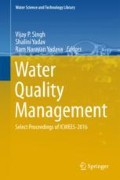Abstract
The beam house operations in tanning process of hides/skins comprise of soaking, liming, fleshing and deliming operations. The removal of animal hair and flesh from skin is facilitated by the liming operation. About 5 m3/ton of wastewater containing a credible concentration of sulphide and dissolved proteins are discharged in tannery process. It is highly alkaline and having high BOD/COD ratio. The biological treatment of wastewater occurs at neutral pH requires neutralization of the wastewater using acidic stream. This results in the emission of hydrogen sulphide which is considered to be highly toxic gas. The present investigation employed Heterogeneous Peroxide Oxidation process (HPO) for the oxidation of sulphide in the lime sulphide liquor without sludge production with simultaneous removal of COD from wastewater. The screened effluent was adjusted to pH 9.7 using conc. sulphuric acid, and it is catalytically oxidized with hydrogen peroxide 3.921 mM/L and nanoporous activated carbon (NPAC), 30 g/L at HRT 24 h. The dosage of hydrogen peroxide, mass of NPAC and HRT were optimized. The integrated catalytic and biological oxidation in Fluidized Immobilized Carbon Catalytic Oxidation (FICCO) reactor eliminated COD, sulphide, total Kjeldahl nitrogen, protein, amino acids and TOC by 66.66, 98.95, 75.67, 44.21, 48.98 and 62.18%, respectively. The sulphide present in the wastewater was catalytically oxidized to sulphate, and ammonia content was increased about 78.05% by cleaving protein molecules.
Access this chapter
Tax calculation will be finalised at checkout
Purchases are for personal use only
References
Abraham RT, Benson LM, Jardine I (1983) Synthesis and pH-dependent stability of purine-6-sulfenic acid, a putative reactive metabolite of 6-thiopurine. J Med Chem 26:1523–1526
Aravindhan R, Madhan B, Rao JR, Nair BU, Ramasami T (2004) Bioaccumulation of chromium from tannery wastewater: an approach for chrome recovery and reuse. Environ Sci Technol 38(1):300–306. doi:10.1021/es034427s
Anglada A, Urtiaga A, Ortiz I (2009) Contributions of electrochemical oxidation to waste-water treatment: fundamentals and review of applications. J Chem Technol Biotechnol 84:1747
Bach RB, Ayala PY, Schlegel HB (1996) A reassessment of the bond dissociation energies of peroxides. an ab initio study. J Am Chem Soc 118:12758–12765
Burkhard RK, Sellers DE, DeCou F, Lambert JL (1959) The pKa’s of aromatic sulfinic acids. J Org Chem 24:767–769
Control of Urban Pollution Series: Cups (2009–10) Central Pollution Control Board Ministry of Environment & Forests, Jan 2009
Dahl O (1999) Evaporation of acidic effluent from kraft pulp bleaching, reuse of the condensate and further processing of the concentrate. Oulu University, Oulu
Davies RM (1997) Setting of consent limits for tanning industry trade effluents. J Soc Leather Tech Ch 81:32–36
Ganesh R, Ramanujam RA (2009) Biological waste management of leather tannery effluents in India current options and future research needs. Int J Environ Eng 1:165–186. doi:10.1504/IJEE.2009.027313
Huber CV, De SM (1990) Toxicity of tannery effluent —the next concern. J Am Leather Chem Assoc 85(8):276–286
John Kennedy L, Mohan das K, Sekaran G (2004) Integrated biological and catalytic oxidation of organics/inorganics in tannery wastewater by rice husk based mesoporous activated carbon department of environmental technology. CSIR-CLRI Carbon 42:2399–2407
Kumara Sashidara P, Sharmila J, Karthikeyan S, Sekaran G (2013) Treatment of domestic sewage through immobilized cell reactor with minimum sludge production. Res J Eng Tecnol 4(4):8
Lacorte S, Latorre A, Barceló D, Rigol A, Malmqvist A, Welander T (2003) Organic compounds in paper-mill process waters and effluents. Trends Anal Chem 22(10):725–737
Marsal A, Cot J, Boza EG, Celma PJ, Manich AM (1999) Oxidizing unhairing process with hair recovery. Part I. experiments on the prior hair immunization. J Soc Leather Tech Ch 83:310–315
Mesdaghinia AR, Yousefi Z (1991) The use of oxygen in catalytic oxidation of sulfide in tannery wastewater. Iranian J Publ Health 20(1–4):17–26
Obuka NSP, Celestine ON, Ikwu, Gracefield Reuben O, Chukwumuanya, Okechukwu E (2012), Review of corrosion kinetics and thermodynamics of CO2 and H2S corrosion effects and associated prediction/evaluation on oil and gas pipeline system. Int J Sci Tecnol Res 1(4) (ISSN 2277–8616)
Patai S, Rappoport L, Stirling CJM (1988) The chemistry of sulfoxides and sulfones. Wiley, New York, p 120231206
Schraeder CE, Ervin RT, Eberspacher JL (1998) Economic analysis of the feasibility of using enzymes in the unhairing process. J Am Leather Chem Assoc 93(9):265–271
Sekaran G, Chitra K, Mariappan, M (1995) Removal of sulphide in tannery effluent by wet oxidation. J Sci Leather Techno Chemists 79:123–126
Sekaran G, Chitra K, Mariappan M, Raghavan KV (1996) Removal of sulfide in anaerobically treated tannery wastewater by wet air oxidation. J Environ Sci Heal A 31(3):579–598
Swarnalatha S, Kumar AG, Sekaran G (2009) Electron rich porous carbon/silica matrix from rice husk and its characterization. J Porous Mater 16(3):239–245
Taylor MM, Bailey DG, Feairheller SH (1987) A review of the uses of enzymes in tannery. J Am Leather Chem Assoc 82:153–165
Valeika V, Beleška K, Valeikienė V (2006) Oxidation of sulphides in tannery wastewater by use of manganese (IV) oxide kaunas. Chem Technol Fac Polish J Environ. Stud 15(4):623–629
Acknowledgements
The authors are very thankful for providing the facilities through the project INDO-VIETNAM JOINT RESEARCH PROJECT GAP1065, CSIR-CLRI to carry out the research work and we would like to thank Centralised Sophisticated Instruments Facility centre of CSIR-CLRI for helping us to analyse TGA.
Author information
Authors and Affiliations
Corresponding author
Editor information
Editors and Affiliations
Rights and permissions
Copyright information
© 2018 Springer Nature Singapore Pte Ltd.
About this paper
Cite this paper
Prabhakaran, N., Swarnalatha, S., Sekaran, G. (2018). Catalytic Oxidation of Sulphide Laden Tannery Wastewater Without Sludge Production. In: Singh, V., Yadav, S., Yadava, R. (eds) Water Quality Management. Water Science and Technology Library, vol 79. Springer, Singapore. https://doi.org/10.1007/978-981-10-5795-3_10
Download citation
DOI: https://doi.org/10.1007/978-981-10-5795-3_10
Published:
Publisher Name: Springer, Singapore
Print ISBN: 978-981-10-5794-6
Online ISBN: 978-981-10-5795-3
eBook Packages: Earth and Environmental ScienceEarth and Environmental Science (R0)

